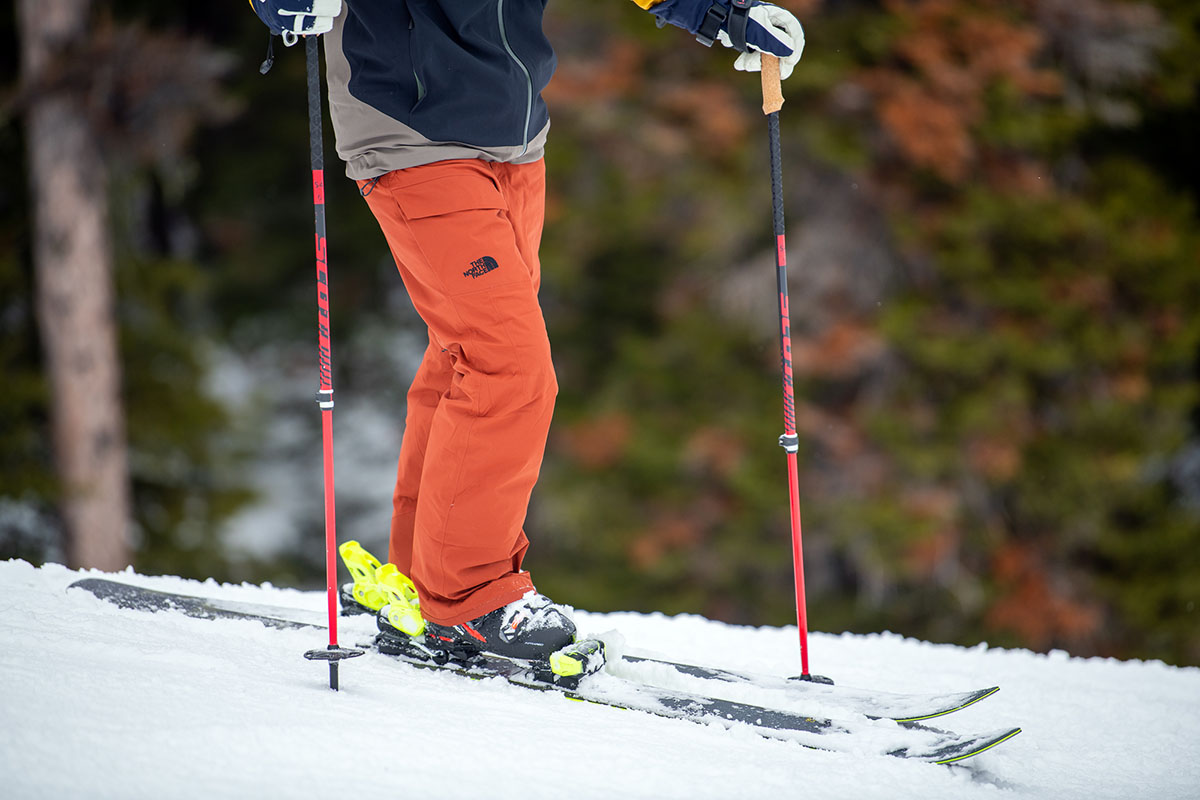
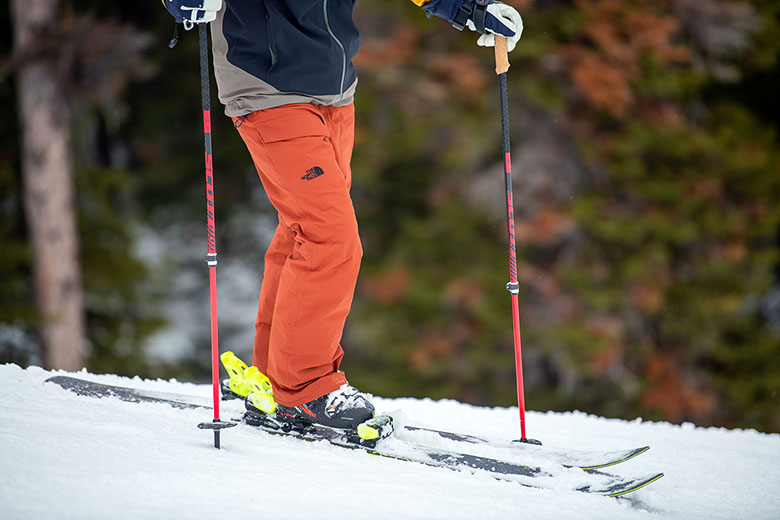
Switchback Travel (Jason Hummel)
Ski pants are a critical barrier between you and the elements, and there’s a pair to fit every type of skier and budget. Resort-goers typically opt for a classic hardshell design with some light insulation to stay warm on the lift rides up. Backcountry skiers have plenty of softshell and stretch-infused options for improved range of motion and breathability. Of course, some of our recommended ski pants toe the line for those who like to do a little of both. Below are the best ski pants for the 2024-2025 season, along with our comparison table and buying advice after the picks. Of note: This article includes options for both men and women, but we’ve also written a dedicated round-up on the best women’s ski pants.
Editor’s note: We updated this ski pants guide on October 16, 2024, to include information about our testing practices and ensure all prices, colorways, and write-ups were up to date at the time of publishing.
 Best for: Resort and backcountry
Best for: Resort and backcountry
Type: Hardshell
Insulated: No (thin fleece backer)
What we like: Fantastic build quality, weather protection, and versatility.
What we don’t: Latest model has a tricky fit; very pricey.
If we were to pick one ski pant for anywhere on the mountain, for conditions from bluebird to overcast and wet, it would be the Arc’teryx Sabre. These pants nearly have it all: 80D 3-layer ePE Gore-Tex for bomber protection from the elements, a lightweight fleece backer for comfort and a touch of warmth, and a solid feature set with plenty of storage. Attention to detail is also a Sabre hallmark, and the light-yet-burly construction is a nice break from the overly heavy and bulky feel that you get with most ski pants. As with most Arc’teryx gear, price is the biggest obstacle, and it’s a significant investment if you don’t plan to get out a lot (one of the budget options below may be better for occasional riders).
For best uses, the Sabre is an excellent choice for active resort skiers and those who like to venture beyond the ropes into the sidecountry. These pants won’t be out of place during trips in the backcountry either, with fantastic range of motion, along with big side vents for dumping heat. That said, Arc’teryx tweaked the fit a couple seasons ago, and we weren't fans: Both of our testers complained of a short rise and shorter-than-expected inseam. Neither issue was a dealbreaker—and Arc’teryx does now offer three different inseam options (short, regular, and tall), as well as a relaxed fit version. We will also be testing the newest version this season and will report back on this issue. But all told, if the Sabre Pants work for you, they’re a winning design year after year (and there's even a bomber bib version, too)... Read in-depth Sabre Pant review
See the Men's Arc'teryx Sabre Pant See the Women's Arc'teryx Sentinel Pant
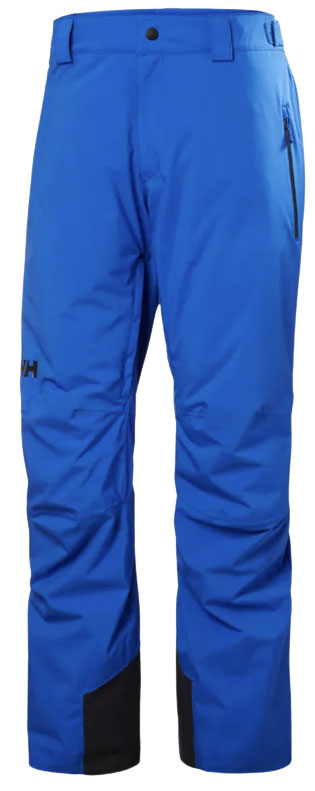 Best for: Resort
Best for: Resort
Type: Hardshell w/ stretch
Insulated: Yes (60g synthetic)
What we like: Just-right warmth, stretchy and comfortable fit, and a great price.
What we don’t: Material is prone to showing wear over time.
For a super clean resort pant with a great fit and just-right warmth, give the Legendary Pant from Helly Hansen a look. The 2-layer waterproof shell is ideal for those who aren’t frequently working up a sweat—and helps keep costs in check—and the Legendary has a touch of PrimaLoft in the butt and knees for cold rides on the lift. We also like the lightweight feel and simple design from the Norwegian company, which comes in a variety of colors to match just about any jacket combination.
In terms of movement, the Legendary incorporates a mechanical stretch fabric that offers extra "give," which is great for both sidecountry hikes and downhill travel. The fit also hits a great middle-ground for many riders: It’s not overly bulky like many options in its price range, but there’s still plenty of room for most folks to layer underneath. Our main issue is with the durability of the fabric. The relatively thin materials and price-conscious build aren’t quite up to par with Patagonia’s Storm Shift below or Arc’teryx’s Sabre above, and the pants will show more wear over time. But the Legendary costs far less than those alternatives, and its blend of comfort, price, and performance earns it our top resort pick for multiple years running.
See the Men's Helly Hansen Legendary See the Women's Helly Hansen Legendary
 Best for: Resort
Best for: Resort
Type: Hardshell
Insulated: Yes (40g polyester)
What we like: Excellent value for a well-rounded resort design.
What we don’t: Not built for particularly wet conditions.
REI’s in-house outerwear continues to impress when it comes to bang for your buck, and their Powderbound ski kit is no exception. Overall, we think they’ve put together a solid product with the insulated pant: The 2-layer Peak waterproofing holds up to most winter weather, and a moderate level of insulation (40g) adds a nice layer of protection on a frozen chairlift. Tack on a thoughtful set of ski-specific features—boot gaiters and scuff guards, Velcro waist adjustments, and a nice assortment of fleece-lined pockets—and the Powderbound is well suited for life at the resort.
Like most ski pants in this price range, the Powderbound is only critically seam sealed, which keeps costs low but isn’t great for staying dry in sustained and wet snowfall (or on rainy chairlifts). For folks that get out a lot—and in wet conditions—we think it’s worth spending up for a more protective option. The Powderbound’s zipper flaps (rather than water-resistant zippers) also lend a rather budget vibe. But the rest of the design is well sorted, including vents along the inner thigh (something Columbia’s slightly cheaper Bugaboo V below omits) and a sleek zippered pocket on the right. In the end, the Powderbound Insulated earns our best budget spot and is a great option for casual, fair-weather, and occasional skiers alike. And for those that like a little more coverage, the Powderbound is also available in a bib version for $219.
See the Men's REI Powderbound Insulated See the Women's REI Powderbound Insulated
 Best for: Backcountry
Best for: Backcountry
Type: Hardshell w/ stretch
Insulated: No
What we like: Thin and stretchy 3-layer fabric balances comfort, breathability, and waterproofing.
What we don’t: Expensive and slim-fitting; nitpicks with some features.
Not only does backcountry skiing require a distinct skill set from resort skiing, it’s also best done with a completely different set of gear. Balancing uphill and downhill performance, backcountry ski pants generally feature a slim fit (read: less fabric getting in the way climbing the skin track), thin, breathable, and stretchy materials, and features like large vents and a beacon-compatible pocket. The newly redesigned Patagonia Stormstride is one of the most purpose-built pants out there, getting the job done with a stretchy 40-denier nylon shell and reliable 3-layer H2No Performance Standard waterproofing.
We love the sleek and streamlined look and feel of the Stormstride, which checks in at about a half-pound to a pound lighter than most pants here. And after over a season of rigorous backcountry use, they’ve shown impressively few signs of wear or deterioration. However, Patagonia hasn’t landed on the perfect design: Notably, the slim fit is restrictive in areas, and some features are simply too pared down, including the small pockets and non-glove-friendly zipper pulls. And the thin shell fabric is no match for a burlier resort pant (for comparison's sake, Patagonia's Storm Shift below uses 150D nylon): It'll get the job done in light to moderate moisture but will become overwhelmed in stormy conditions. But the Stormstride nevertheless nails the backcountry pant archetype better than most, with a great mix of comfort and mobility, breathability, and waterproofing... Read in-depth review
See the Men's Patagonia Stormstride Pants See the Women's Patagonia Stormstride Pants
 Best for: Resort and backcountry
Best for: Resort and backcountry
Type: Hardshell
Insulated: No
What we like: Bomber protection in wet and deep snow.
What we don’t: Burly build is overkill for mild conditions and high-output use.
For maximum protection when skiing in wet snow and deep powder, it’s hard to beat a bib. And among the many options on the market, Flylow’s Baker is a standout. It has a long track record of waterproof performance from its 3-layer build and DWR coating, is super tough with panels of reinforced Cordura, and has an easily adjustable fit with Velcro tabs on the sides. The Baker also performs well for sidecountry hikes and backcountry tours with a ventilation system that features both massive side vents and zippered openings along the inner thigh.
What do you give up with the Baker’s bib design? The extra waterproof layer around the stomach and lower back makes it run hotter and heavier than a comparable pant, and it’s overkill on mild-weather days. Additionally, the Flylow’s substantial construction and moderately baggy fit can inhibit range of motion for skinning uphill. But the Baker is a perfect match for its namesake mountain: It's built to handle anything from wet, unruly conditions to bottomless powder days. Interestingly, Flylow doesn’t offer an equivalent female version, although their women’s Foxy Bib is a favorite of ours and features similar coverage, organization, and build quality. The key difference is its Tactic 3L construction, which is stretchier, lighter, and thinner than the Baker’s 3L Intuitive build.
See the Men's Flylow Gear Baker Bib See the Women's Flylow Gear Foxy Bib
 Best for: Resort
Best for: Resort
Type: Hardshell
Insulated: No (available)
What we like: Good looks, durable materials, and impressive sustainability measures.
What we don’t: Fit is a little big; expensive for a 2-layer design.
The Storm Shift is one of Patagonia’s premium resort pants and a big step up from most of the 2-layer offerings here. First, you get solid weatherproofing by way of a Gore-Tex membrane and a robust 150-denier shell fabric with a DWR finish. Vents on the outside of the thigh effectively dump heat (we’ve found outer-thigh vents to be better performing than those on the inner thigh), and a brushed tricot liner adds a high-end feel that slides on nicely over baselayer bottoms. Fit-wise, the Storm Shift falls slightly on the big and baggy end (with a 31-in. waist and size medium, we had the side elastic tabs as tight as they would go), but the articulated cut and two inseam options should keep most skiers happy.
Like a lot of Patagonia gear, the Storm Shift is rather pricey at $399. It’s also not a backcountry-specific piece with its heavy 2-layer build and hanging mesh/polyester lining (although the vents along the outer leg do a decent job at dumping heat). But it’s hard to beat the design’s sustainability chops: The Gore-Tex construction is completely PFC-free (including the membrane, DWR finish, and fabric), recycled materials are used throughout, and it’s Fair Trade Certified sewn. For a more affordable alternative from Patagonia, check out their $249 Powder Town Pant below, which has a simplified design and in-house H2No waterproofing instead of Gore-Tex... Read in-depth Storm Shift review
See the Men's Patagonia Storm Shift See the Women's Patagonia Storm Shift
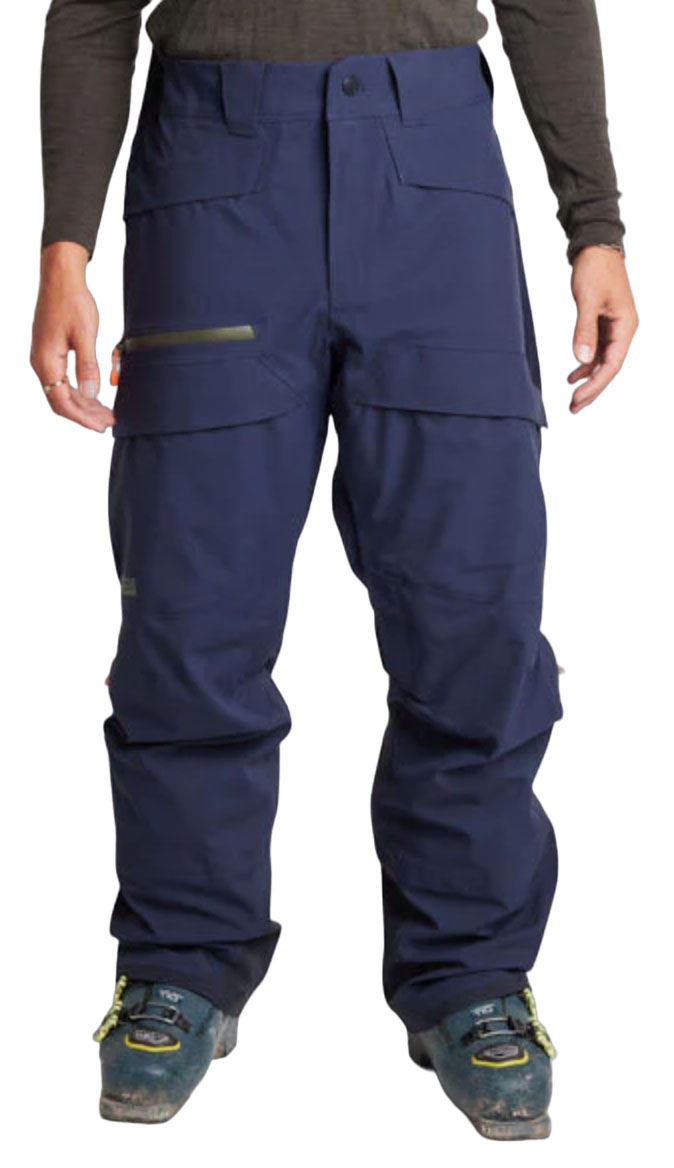 Best for: Resort and backcountry
Best for: Resort and backcountry
Type: Hardshell
Insulated: No
What we like: Fantastic quality, weather protection, and breathability.
What we don’t: Relaxed fit and generous feature set won’t appeal to all backcountry-goers.
Still a young brand, Trew Gear has really broken through in the ski and snowboard markets thanks to their high-quality and clean-looking outerwear designs. The Eagle Pant is one of their best all-rounders: The proprietary 3-layer PNW construction has a premium look and feel, and you get full seam taping, smooth-operating water-resistant zippers, and a total of five pockets (along with reinforced D-rings to secure your avy beacon). Tack on a high-quality fit and finish, burly scuff guards, and generous mesh vents both on the inner and outer leg, and the Eagle is the full package for both resort and backcountry skiers.
The Eagle goes head-to-head with a premium pant like the Arc’teryx Sabre above. Both designs feature weather-worthy 3-layer builds and features that make them viable options for 50/50 resort and backcountry use. The Arc’teryx’s svelter design is lighter weight (by about a half-pound) and less restrictive for uphill travel, while the Trew Gear will appeal more to the freeride crowd with its relaxed fit and mechanical stretch in the build. And at $459 (and currently deeply discounted), the Eagle gets the clear edge in price, although it can’t quite match the barely-there-yet-bomber feel of the Sabre. Other options we love from Trew are the Cooper (men’s) and McKenzie (women’s) pants, which feature affordable 2-layer constructions.
See the Men's Trew Gear Eagle Pant Primo
 Best for: Resort
Best for: Resort
Type: Hardshell
Insulated: No (available)
What we like: Proven and tough resort design; available in a good range of sizes and colors.
What we don’t: Baggy fit isn’t for everyone; design decisions aren't as considered.
For weekend warriors and those who don’t want to spend a ton on ski gear, no pants are more popular at the resort than The North Face Freedom. It’s a classic choice featuring a thick 2-layer construction that is super durable and blocks out wind and snow effectively. The venting system is surprisingly good for a cheaper pant, and Velcro adjusters at the sides of the waist are a simple but effective tool for dialing in fit. Another plus is that the pant is offered in a decently wide range of sizes (XXS to XXL) and three different inseam lengths. To be clear, the Freedom is a noticeable step down in quality from our top picks, but it covers the basics for resort skiers at a great price.
Keep in mind that although the Freedom pants will do the trick for skiing laps and long chairlift rides, performance-minded skiers likely will be left wanting more. To start, the fit is pretty generic—there isn’t any stretch built into the fabric, and they’re quite baggy around the thighs and lower legs. Moreover, it’s fairly easy to overheat with the cheap waterproofing technology, and while we like the zippered vents, their placement along the inner thigh creates extra bulk. All that said, this is a great choice for the casual user, and we appreciate that The North Face lowered the price to be closer to what it once was. Of note: For those that prefer an insulated pant, there’s a Freedom Insulated that’ll run you $200. On the women's side, TNF only offers an insulated or a new stretch version, both for $200... Read in-depth men's review (insulated version)
See the Men's The North Face Freedom Pants
 Best for: Resort and backcountry
Best for: Resort and backcountry
Type: Hardshell
Insulated: No
What we like: Great-fitting and high-quality technical pants that excel in the resort and backcountry.
What we don’t: A bit stiffer, crinklier, and heavier than the Sabre above.
To those that haven’t been introduced, Norway-based Norrøna is a relative newcomer to the U.S. market but has been a strong player for years in Europe. Their gear exudes thoughtful design, quality, and Scandinavian style—it often reminds us of Arc’teryx but with a distinct look and often overbuilt feel (in a good way). The versatile Lofoten Gore-Tex is a core item for the company, and after a season of testing, we came away extremely impressed. The 3-layer Gore-Tex build provides bomber protection, we love the athletic fit for active use, and comfort is notable with a soft Gore C-Knit liner. The details feel well sorted too, with water-resistant zippers and easy-to-grab zipper pulls, along with an optional zip-in bib (a fun add-on that’s sold separately for $69). Additionally, for the 2024/25 season, the pants use the new PFC-free Gore-Tex ePE fabric.
How does the Lofoten Gore-Tex stack up to our top-rated Sabre? Both are fantastic technical designs with reliable Gore-Tex constructions, soft and comfortable interiors, and quality touch points throughout. Differences are relatively minor: The Lofoten is a little burlier, and we like the security of its features, including the overbuilt waist adjuster and solid buttons. On the other hand, the Arc’teryx is a little less stiff and crinkly—a plus while hiking and skinning—and can dump heat faster since there's no mesh backing on the vents (on the other hand, the Norrøna’s are more protective against blowing snow). A final nitpick with the Norrøna is that we don’t love the placement of its thigh pockets, which are set right along the front of the leg (small items can end up in the corner next to your knee). But for a premium design for the 50/50 crowd who dip in and out of the ropes, the Lofoten is well worth a look.
See the Men's Norrøna Lofoten Gore-Tex See the Women's Norrøna Lofoten Gore-Tex
 Best for: Resort
Best for: Resort
Type: Hardshell
Insulated: Yes (80g synthetic)
What we like: One of our favorite insulated resort pants.
What we don’t: Ultra pricey.
Arc’teryx is known for their backcountry prowess, but they can make a sweet resort pant, too. Take the Macai, which is insulated and tough but doesn’t give up the fantastic fit and detailing we love from the venerable British Columbia brand. The pants are bombproof with a 3-layer Gore-Tex shell, provide warmth when temperatures really drop with 80-gram synthetic fill, and include impressively large side zips (at least for a resort pant) for staying cool. As expected, the Macai's mobility is fantastic with a streamlined shape, articulated cut, and strategically placed gussets.
Despite the impressive performance, the Macai strikes us as a very hefty investment considering its cold-weather focus. If you have a closet full of ski pants, the $600 may not be a deterrent, but the lightly insulated Sabre above is more adaptable and useful for the entire season (the insulated version of the Sabre Pant is also an option with 40g synthetic fill). And fit-wise, the two pants are distinct: The Sabre offers a regular fit, while the more-tailored Macai gets a "fitted" designation. Comparisons aside, the Macai is our favorite insulated pant in Arc'teryx's lineup and excels at providing warmth without compromising on performance. We wish there was a women's version, but currently the Macai is only available for men.
See the Men's Arc'teryx Macai
 Best for: Resort and backcountry
Best for: Resort and backcountry
Type: Hardshell
Insulated: No
What we like: A bomber pant that does just about everything well.
What we don’t: Fit is still a little baggy for our tastes.
Flylow Gear flies a little lower under the radar than some of the bigger outdoor gear brands, but the Chemical pant is a solid offering. Like their Baker Bib above, this is a super tough design with a 3-layer build, Cordura patches in high-wear areas like the knees and cuffs, and waterproof zippers. Given the impressive level of protection, they ventilate well, and you can release hot air in four places: two zippered vents along the inner thigh and two large vents along the outside of your legs. It all adds up to a formula that has generated a cult-like following.
The Chemical is the most affordable 3-layer pant here—it’s $35 cheaper than the BD Recon below and almost $100 less than the Trew Gear Eagle above. Compared to the Eagle, both pants offer a baggy fit and classy colorways that will appeal to the freeride crowd, along with availability in six sizes and three inseam lengths. The Trew Gear gets the slight edge for us with its full suite of pockets—five compared to the Flylow’s three (one of which is oddly placed on the rear on the men's version), including secure clips for an avalanche beacon—and its mesh-lined vents do a better job keeping flying snow at bay. But the Chemical (or the Donna for women) is nevertheless a solid crossover ski pant that offers great performance at a lower price than many.
See the Men's Flylow Gear Chemical Pant See the Women's Flylow Gear Donna Pant
 Best for: Backcountry and resort
Best for: Backcountry and resort
Type: Hardshell w/ stretch
Insulated: No
What we like: Good balance of comfort, protection, and breathability.
What we don’t: Not a standout in durability.
Black Diamond hasn’t been in the ski apparel game for long, but their collection is filled with some quality options for backcountry use. Like Patagonia's Stormstride above, BD’s Recon Stretch Pant puts an emphasis on comfort and mobility with a stretch-woven face fabric. Combined with a smooth jersey backer and easily accessible side vents, the Recon is a nice pairing for long stretches on the skin track. Importantly, the Recon also features a waterproof membrane (BD’s in-house design) and full seam sealing, so you don’t have to leave it behind on stormy days.
The Recon Stretch strikes us as a nice one-quiver pant for those who split their time fairly evenly between the backcountry and resort. It’s not going to match Gore-Tex in all-out weatherproofing (those riding in especially wet climates may want to steer clear), but otherwise, there’s little to complain about in terms of performance. Durability is a concern, however, due to the moderately thin fabric. There are reinforcements around the instep, but it’s noticeably less burly than the cuff protection in a pant like the Arc’teryx Sabre above. But if you take care around sharp ski edges and boot buckles, the Stretch Recon is a versatile pant and a decent value at $400.
See the Men's BD Recon Stretch See the Women's BD Recon Stretch
 Best for: Resort
Best for: Resort
Type: Hardshell
Insulated: Yes (60g synthetic)
What we like: Affordable and tough for occasional resort use.
What we don’t: Not fully waterproof and pretty cheap materials overall.
Columbia’s Bugaboo Pant has been a long-time favorite among beginner skiers. The price is right at $120, which includes a durable and hardwearing exterior, waterproof lining, and a healthy dose of warmth with its 60-gram synthetic insulation. In addition, Columbia incorporates a surprising number of useful features: The adjustable waistband makes it quick and easy to customize the fit (it secures with Velcro), and the hand pockets are nicely sized for storing essentials like a lift pass and keys. Totaled up, the Bugaboo Pant is everything a first-timer or occasional skier needs and nothing they don’t.
The Bugaboo gives REI's Powderbound above a run as our favorite budget ski pant but comes up short in a few key areas. First, the Bugaboo is only critically seam taped, which means that it’s less weather-worthy and can succumb to extended moisture more readily. This likely will only be an issue on especially wet snow days, but it’s something to take note of. Further, you miss out on zippered vents for dumping heat, and the material quality is a step-down and likely won’t hold up as well in the long run as the Powderbound. That said, for $39 less and with a similar feature set, it’s hard to knock the Bugaboo’s bang for the buck. Of note: The comparable women's pants are only on version II, but despite the difference in iteration, they are the same pants.
See the Men's Columbia Bugaboo V See the Women's Columbia Bugaboo II
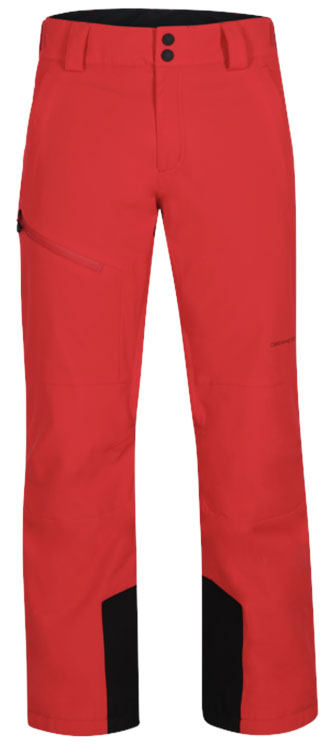 Best for: Resort
Best for: Resort
Type: Hardshell
Insulated: Yes (40g synthetic)
What we like: Upgraded features and a more tailored cut than The North Face Freedom.
What we like: Not a standout in terms of value; comparable women's version isn't nearly as considered.
The $200 price range is chock-full of ski pant options, but the Obermeyer Force makes its case with a nice fit and modest upgrades from many budget models. To start, the smooth-operating water-resistant zipper on the front pocket is a surprising addition for a mid-range design, and it gives the pant a premium, technical look. Additionally, you get a more tailored fit around the legs than The North Face Freedom above, and reinforcements at high-wear areas like the seat and knees make it fully resort-ready.
One notable downside is that all of the extras don’t hide the budget-oriented waterproof construction, which is comparable to pants costing much less (including the aforementioned Freedom). The same goes for the zippered vents, which are located along the inner leg—like most cheap options—and add bulk. For $29 less, Helly Hansen’s Legendary above offers a nice boost in comfort with its stretchy shell and comparable warmth. That said, if you like the fit and styling, the Force is a very serviceable resort choice. Unfortunately, Obermeyer didn't put the same attention into the women's Bliss Pant, which appears to be the closest match. The Bliss is $30 cheaper, but doesn't have as robust seam sealing, has smaller thigh vents, and has decidedly less useful pockets. That's not a recipe for bliss, in our opinion.
See the Men's Obermeyer Force Pant See the Women's Obermeyer Bliss Pant
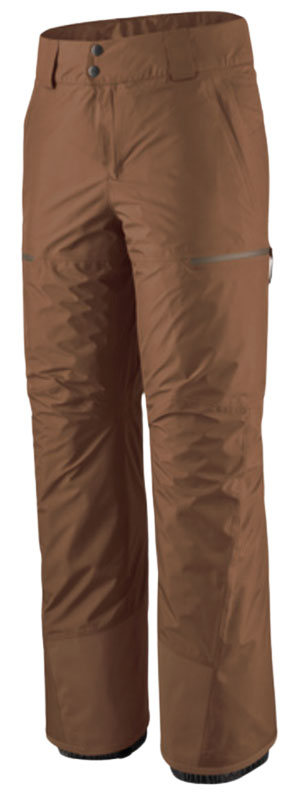 Best for: Resort
Best for: Resort
Type: Hardshell
Insulated: No (available)
What we like: Premium features at a mid-range price point.
What we don’t: Relatively thin fabric; DWR finish wore off quickly during our testing.
Patagonia doesn’t have any true entry-level ski pants, but the resort-oriented Powder Town is their most affordable offering at $249. The Powder Town keeps prices low with an in-house H2No Performance Standard membrane, uninsulated build, and a simple yet functional feature set that includes two front pockets and two cargo pockets, boot gaiters and scuff guards, and large velcro tabs at the waist for adjusting the fit. And the pants are now fully PFC-free, which eliminates the harmful chemicals typically associated with waterproof membranes and finishes.
For $79 more than The North Face’s Freedom, the Powder Town is a notable step up in a few ways. The mesh-lined outer thigh vents do a better job dumping heat and aren’t as cumbersome as the Freedom’s inner thigh vents, and the waterproof zippers lend a high-end feel with minimal bulk. The Powder Town also features significantly thinner fabric (75D vs. the TNF’s 160D x 140D) , which is a boon for breathability and freedom of movement but won’t hold up as well to extended resort use. We did find that the DWR finish wore off very quickly in our testing, but it’s hard to expect more at this price point (and you can always reapply an aftermarket DWR like Nikwax). All told, the Powder Town is a high-value pant from Patagonia, and is also offered in an insulated pant and bib versions… Read in-depth women's review (insulated version)
See the Men's Patagonia Powder Town See the Women's Patagonia Powder Town
 Best for: Backcountry and resort
Best for: Backcountry and resort
Type: Hardshell w/ stretch
Insulated: No
What we like: Breathable, stretchy, and comfortable.
What we don’t: Not as wind- or waterproof as a non-stretch hardshell, no women's version.
Based in Aspen, Colorado, Strafe Outerwear has a strong following among the backcountry ski crowd. Their most popular pant is the men's Capitol 3L, which features the brand’s in-house Recon Elite 3L waterproof construction. Like Patagonia’s H2No Performance Standard, the air-permeable face fabric and membrane are highly breathable and have a lot of stretch that moves with you nicely on the uphill, but the pant doesn’t block out wet snow and frigid wind as well as a standard Gore-Tex hardshell. Overall, the Capitol should be a good pairing for the dry snow of the Rocky Mountains as well as mild days in spring.
Among backcountry-focused models, Patagonia’s Stormstride above is a strong competitor to the Strafe. Both excel for touring, but we like that the Capitol includes extras like removable suspenders and has a thicker construction (63D vs. 40D). This boost in fabric weight lends itself both to durability and weather protection, making us more likely to recommend the Capitol as a 50/50 resort and backcountry piece. But the stretchy face fabric is still more prone to soaking up moisture than a thicker and rigid hardshell, and the clincher for many will be price: At $509, the Capitol is more expensive than the $449 Stormstride, plus it’s only available in a men's version. Gripes aside, Strafe's backcountry pant is well-made and a strong performer in the category, and should continue to be an on- and off-piste favorite. The most technical offering for women is currently the $549 Scarlett 3L Shell Bib, which we haven't gotten to test yet, but will report back when we do.
See the Strafe Capitol 3L Shell Pant
 Best for: Backcountry
Best for: Backcountry
Type: Softshell & hardshell
Insulated: No
What we like: Mixed construction offers a nice combination of protection, mobility, breathability, and comfort.
What we don’t: Not enough waterproofing for wet days.
The Patagonia Stormstride above offers stretchy hardshell protection for backcountry skiers, but the Trailbreaker Tour takes uphill performance to the next level. This pant is business at the bottom and comfort on top, with supple softshell fabric around the waist and thighs and a burly 3-layer Ventia from the knees down. The result is waterproof protection where you need it (for the most part) and a stretchy and breathable pant everywhere else, which is great news for heated sessions on the skin track. And with outer thigh vents, plenty of storage (including a beacon pocket with clip), internal gaiters with power-strap slots for quick transitions, and zip cuffs that expand to fit a range of boot sizes, the Trailbreaker sets itself apart from generic softshell designs as a fully featured ski pant.
Of course, there are a number of tradeoffs when opting for such a trimmed-down model. Firstly, the lack of waterproofing across the rear limits your ability to take trailside breaks or lounge in a backcountry snow kitchen. Further, with no coverage across the thighs, we don’t recommend these pants for deep powder conditions or particularly wet days out. And finally, the fairly snug fit doesn’t allow room for much more than a thin baselayer underneath, which means you’ll need to stay moving in frigid temps (that said, the woven material provides more insulation than a thin hardshell). But for softshell lovers who want a little extra protection, the aptly named Trailbreaker Tour is a purpose-built option and a great value at $249.
See the Men's OR Trailbreaker Tour See the Women's OR Trailbreaker Tour
| Pant | Price | Best for | Type | Insulated | Fabric | Weight |
|---|---|---|---|---|---|---|
| Arc'teryx Sabre Pant | $600 | Resort/backcountry | Hardshell | No (flannel) | 3-layer | 1 lb. 6.8 oz. |
| Helly Hansen Legendary | $200 | Resort | Hardshell w/stretch | Yes | 2-layer | 1 lb. 5.2 oz. |
| REI Powderbound Ins. | $159 | Resort | Hardshell | Yes | 2-layer | 1 lb. 9 oz. |
| Patagonia Stormstride | $449 | Backcountry | Hardshell w/stretch | No | 3-layer | 1 lb. 0.8 oz. |
| Flylow Gear Baker Bib | $430 | Resort/backcountry | Hardshell | No | 3-layer | 2 lb. 1.6 oz. |
| Patagonia Storm Shift | $399 | Resort | Hardshell | No | 2-layer | 1 lb. 10.2 oz. |
| Trew Gear Eagle Primo | $459 | Resort/backcountry | Hardshell | No | 3-layer | 1 lb. 13 oz. |
| The North Face Freedom | $170 | Resort | Hardshell | No (avail.) | 2-layer | 1 lb. 3.4 oz. |
| Norrøna Lofoten Gore-Tex | $579 | Resort/backcountry | Hardshell | No | 3-layer | 2 lb. 0.1 oz. |
| Arc'teryx Macai Pant | $600 | Resort | Hardshell | Yes | 3-layer | 1 lb. 8.7 oz. |
| Flylow Chemical Pant | $365 | Resort/backcountry | Hardshell | No | 3-layer | 1 lb. 11.2 oz. |
| Black Diamond Recon | $400 | Backcountry/resort | Hardshell w/stretch | No | 3-layer | 1 lb. 9 oz. |
| Columbia Bugaboo V | $120 | Resort | Hardshell | Yes | 2-layer | Unavailable |
| Obermeyer Force Pant | $229 | Resort | Hardshell | Yes | 2-layer | Unavailable |
| Patagonia Powder Town | $249 | Resort | Hardshell | No (avail.) | 2-layer | 1 lb. 5.8 oz. |
| Strafe Capitol 3L Shell | $509 | Backcountry/resort | Hardshell w/stretch | No | 3-layer | 1 lb. 10.6 oz. |
| OR Trailbreaker Tour | $249 | Backcountry | Soft & Hardshell | No | 2 & 3L | 1 lb. 7.9 oz. |
As the snow begins to fall and you're gearing up to hit the slopes, you'll obviously want the right skis or snowboard, but having the right apparel is also crucial for your overall comfort and safety. The Switchback Travel crew has been testing ski pants since 2015 when former editor-in-chief and lifelong skier John Ellings put together our first guide with 7 pairs of pants. Some of those pants are such classics that they remain on our list of picks to this day; staples like the The North Face Freedom, Columbia Bugaboo, and Flylow Chemical Pant. John also enlisted the help of longtime contributors Brian McCurdy and Sasha Brown, especially when honing in on our recommendations for more backcountry-specific options. In 2024, senior editor Chris Crossen joined the team, bringing decades of experience and expertise to this very impressive table. Chris is also a lifelong skier and is currently based in the Lake Tahoe area where skiing opportunities abound.
Our current lineup of 17 ski pants reflects years of hands-on experience, our continuous testing practices, and feedback from the larger skiing community. When we test ski pants and bibs, we look closely at factors like waterproofing, breathability, and how well-considered the features are for different use cases. We also take a hard look at durability, paying attention to how well each pant holds up over time and in different types of terrain. Finally, we recognize that the best available options are always changing, so we continue to test noteworthy designs as they become available, adding any standouts to the list above in an iterative cycle.

Ski pants are designed for use at the resort, deep in the backcountry, or a mix of the two, so we’ve included a “best for” specification in our product descriptions and table above. Starting with inbounds skiing, these pants are built tough—you typically get strong face fabrics, fully waterproof and windproof constructions, and generous fits for layering. If you consistently ski in frigid temperatures, it may be worth considering an insulated design, although we sometimes prefer the flexibility of a thick, non-insulated shell for season-long use.
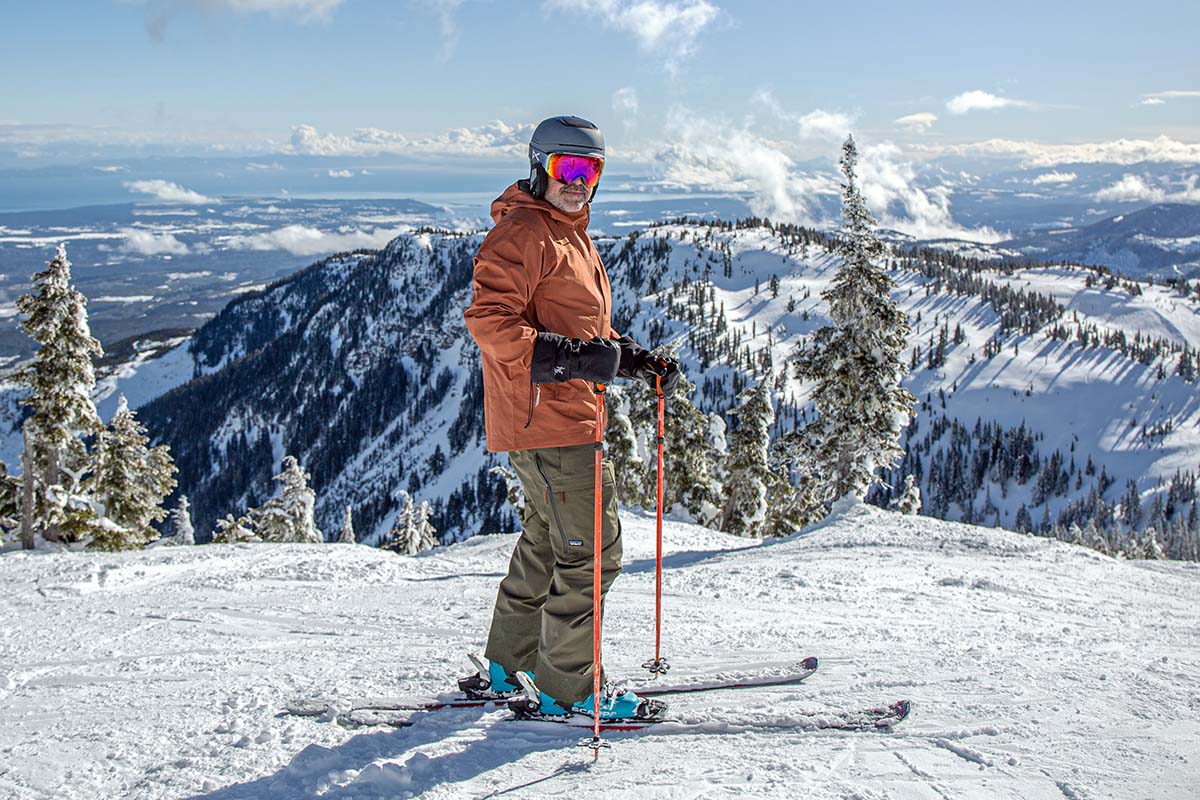
Traveling uphill while breaking trail or on the skin track has an impact on your pant needs. First off, mobility and freedom of movement are very important for backcountry use, so you’ll often find some form of stretch built into the fabric and an athletic fit. Additionally, breathability is essential—the materials on pants optimized for the backcountry are thinner and you get large zippered side vents for staying cool. Finally, all-out weather protection can sometimes be compromised in the quest to keep you from overheating (whether or not this is a good idea for you will depend on your local weather and snow conditions). For those looking for a single pant for mixed use, we still recommend a substantial waterproof design, such as the Arc'teryx Sabre, Trew Gear Eagle, or Norrøna Lofoten Gore-Tex.
.jpg)
In general, modern ski pants are built with one of three types of shell fabric: hardshell, hardshell with mechanical stretch, or softshell. The type of fabric you opt for will depend on where you're skiing (we favor hardshells for resort use) and how much mobility you need (stretchy designs are great for mogul skiers and uphill enthusiasts). The vast majority of skiers will opt for a pant that uses hardshell or hardshell with integrated stretch, but we've also included a softshell hybrid model on our list above.
Hardshell
For most resort days, it’s hard to beat a traditional hardshell pant. Hardshells provide a reliable barrier against wet snow and harsh winds (great for long chairlift rides), and pricier options can have impressively long lifespans. Due to their burly constructions, hardshells aren't particularly breathable, and you'll have to put up with their more rigid feel. But resort skiers generally don’t need an especially breathable or supple pant, and the good news is that most hardshells here have side vents to dump heat on warmer days. The Flylow Chemical Pant is a standout example, with bombproof 3-layer protection, a substantial 150-denier face fabric, and generous vents on both the inside and the outside of the legs.
.jpg)
Hardshell with Stretch
Hard-charging resort skiers, sidecountry enthusiasts, and most backcountry skiers will want a waterproof pant, but a little extra stretch is an appreciated feature. Designs like the Patagonia Stormstride and Strafe Capitol feature a hardshell construction with built-in stretch, which is a lot more supple than a standard hardshell—you don’t get that rigid and crinkly feel—and places a premium on freedom of movement and breathability. However, you do compromise a bit in the way of all-out protection: Stretchy fabrics allow more air to flow than a hardshell, so they feel less impervious in strong gusts. Additionally, they’re more prone to wetting out after extended exposure. But it doesn’t get much better for most backcountry skiers, and it’s for good reason that we see more stretch-infused hardshell pants hitting the market each year.
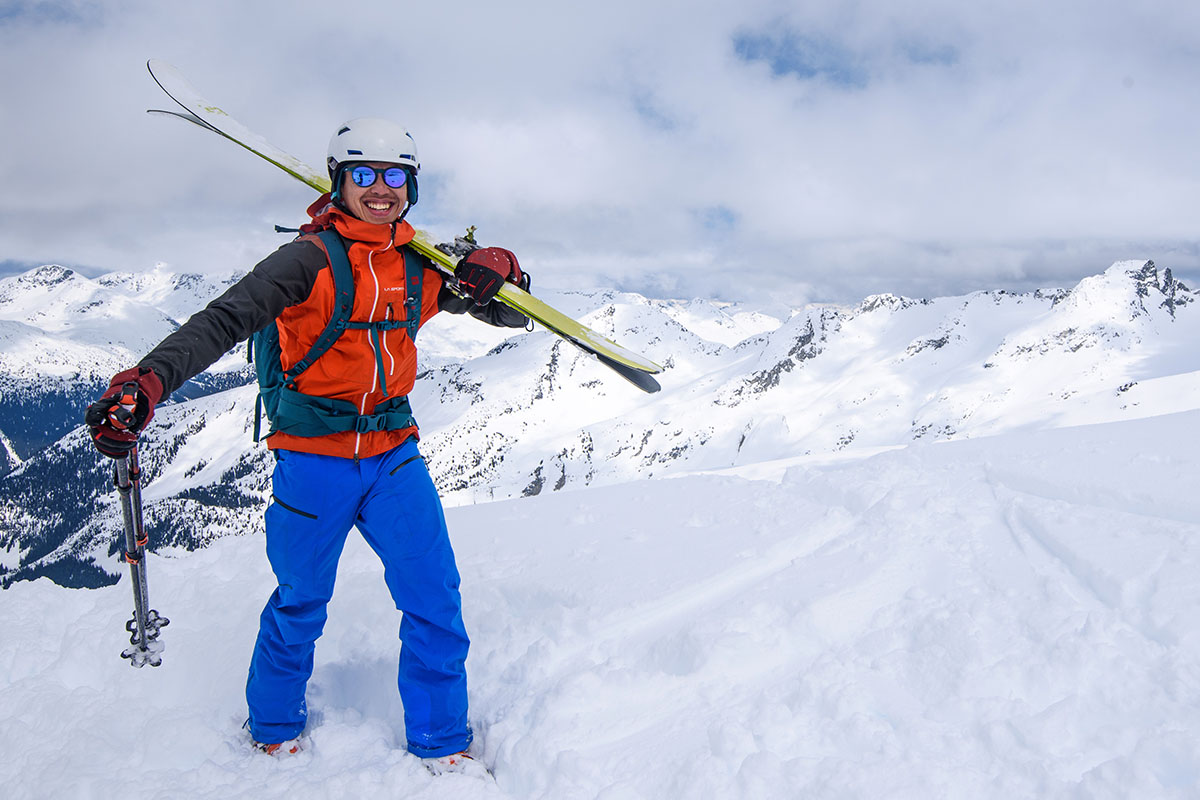
Softshell
On the far end of the spectrum are pants that feature softshell construction, such as the Outdoor Research Trailbreaker Tour, which has softshell fabric above the knees. This material is stretchy, air-permeable, and soft against the skin, which makes it great for high-output pursuits. On the flip side, softshells absorb moisture much more readily than hardshells, and many options lack a waterproof membrane. As a result, a softshell pant is a bad pairing in wet weather—even sitting on snow for an extended period can be a problem—so we don't recommend them for particularly soggy days or resort use.
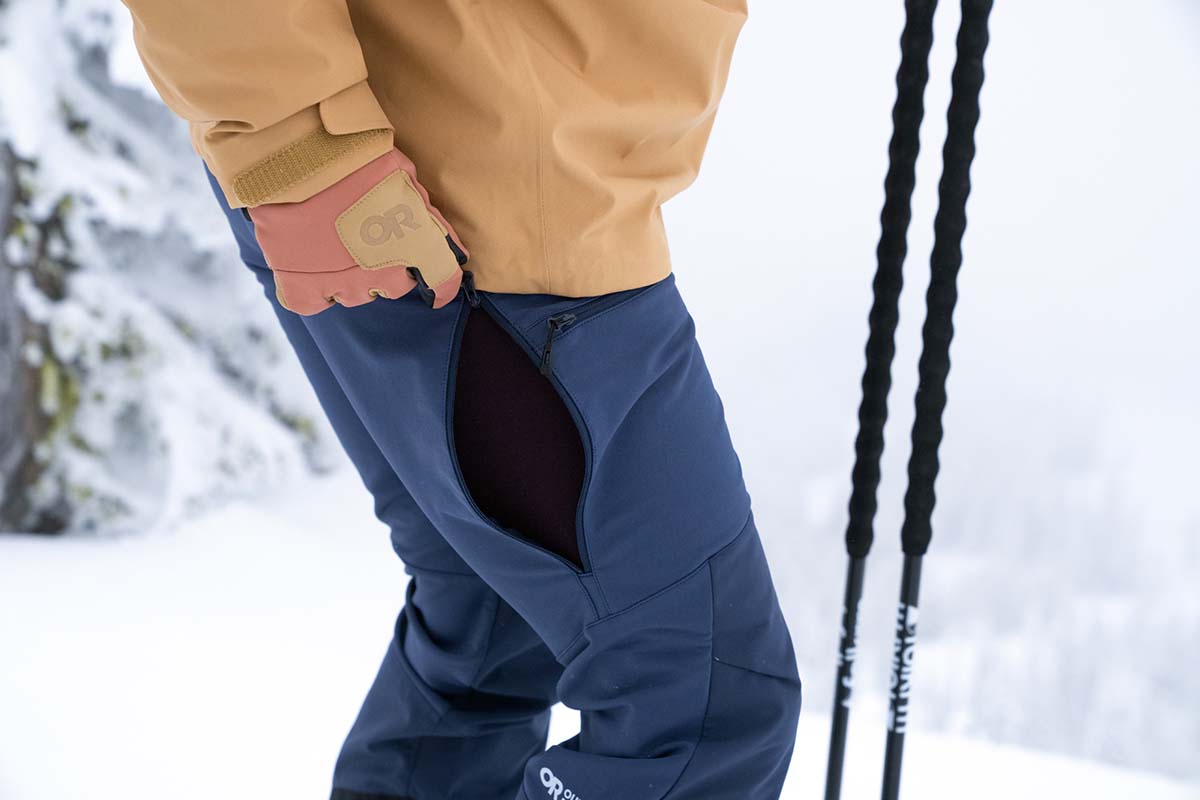
In terms of warmth, ski pants fall into two basic categories: models with built-in synthetic fill and uninsulated shells. Resort skiers, and especially those that stick to groomed runs, will be best off with an insulated model. The boost in warmth is useful to fend off the chill, and the thicker construction provides an additional barrier between you and a frigid chairlift seat (or when sitting on snow). As mentioned above, the vast majority of insulated ski pants use synthetic fill due to its affordability and that it continues to insulate even when wet (unlike goose or duck down). The amount of warmth offered doesn’t vary too widely, and most use somewhere between 40- and 80-gram fill. The ideal amount for you will depend on your local conditions, skiing style (aggressive or casual), and if you’re prone to running hot or cold. Opting for a pant with 60-gram synthetic is a safe bet, and a design like the Helly Hansen Legendary is often the sweet spot for many skiers.
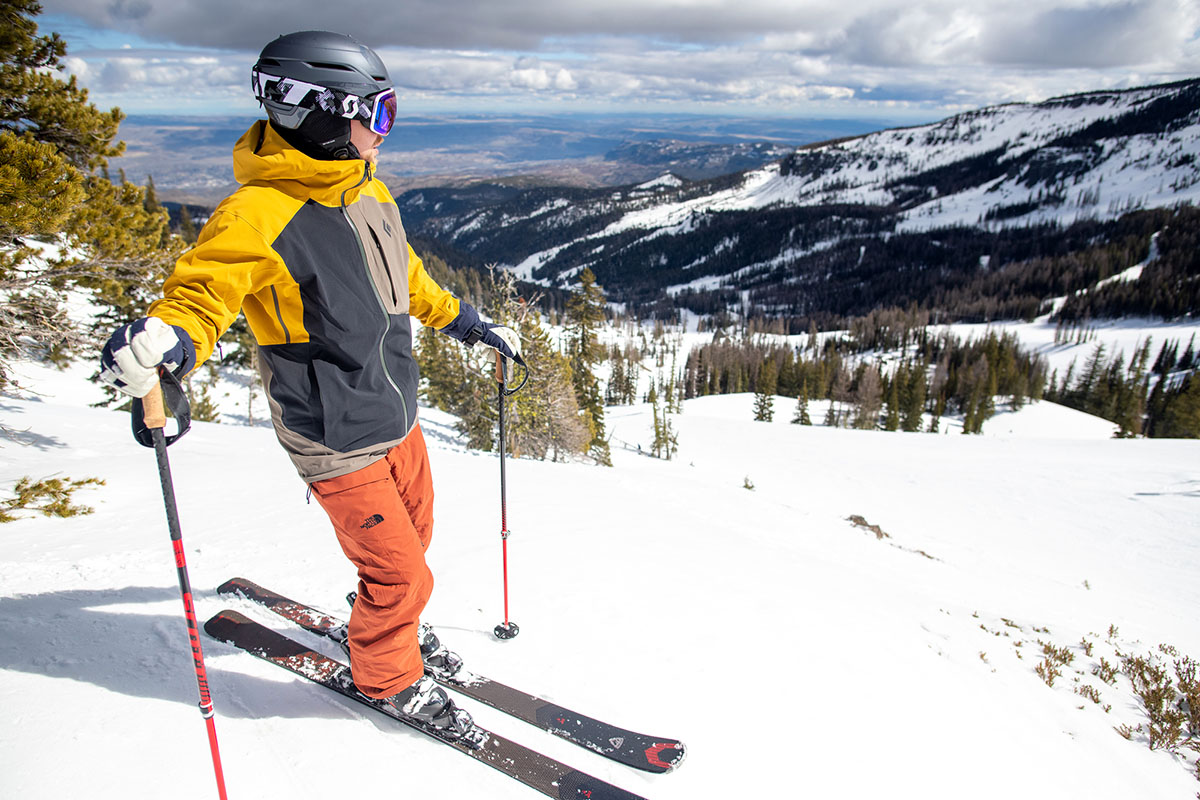
That being said, an uninsulated pant makes a lot of sense for hard chargers or those who plan to ski the side- and backcountry. A shell pant won’t be as prone to overheating if you’re a mogul rider, spend a lot of time off-trail in soft snow, or if you do any extended hiking. And if you’ll be ski touring, a shell pant is a must-have to stay as cool as possible. A final benefit of foregoing insulation is that you can tune your baselayer depending on conditions: For spring-time or active use, you can opt for a lightweight model, and mid or heavyweight baselayers are great in the cold. Again, those planning on lapping the resort will most likely prefer the extra isolation and comfort of an insulated design, but there are a number of situations where a shell is the preferred option.
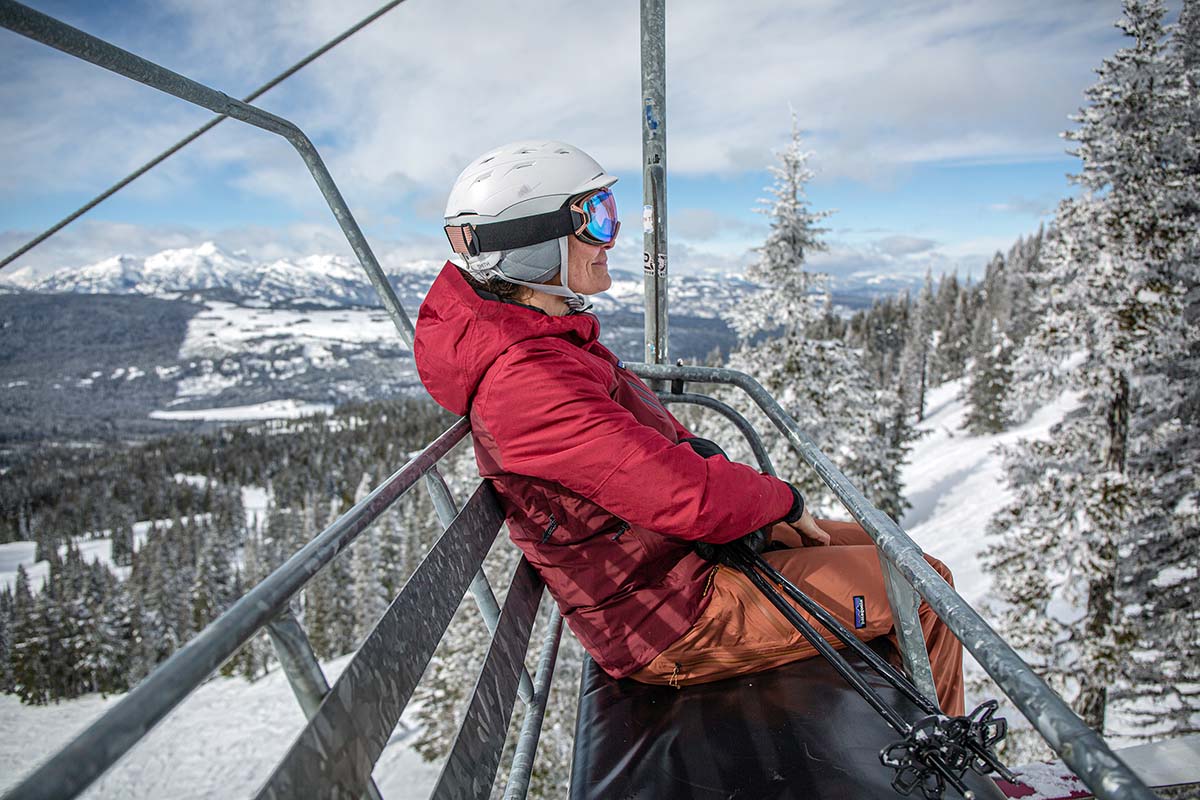
Most premium ski pants have a 3-layer construction, which incorporates three separate pieces of fabric: an outer shell, the actual waterproof and breathable membrane, and an inner lining. This makes it less bulky compared to a 2-layer design (these require a separate, hanging mesh liner along the interior) and also improves breathability and next-to-skin comfort. 3-layer pants are more expensive than 2-layer models and often involve big names like Gore-Tex and AscentShell. As a result of their strengths, 3-layer pants are popular among serious downhill and backcountry skiers.
Many mid-range and budget ski pants have a 2-layer construction. These are less breathable than 3-layer designs, although the simple designs often use thick fabrics that are quite durable. We’ve found that 2-layer pants are perfectly suitable for resort use where ventilation and mobility aren't as important (those skiing moguls or prone to overheating are exceptions). You can save quite a bit of cash by going this route, as some 2-layer ski pants run around $100 (the Columbia Bugaboo V costs $120, for example). For comparison, the cheapest 3-layer waterproof pant on our list is the Flylow Chemical Pant at $365.
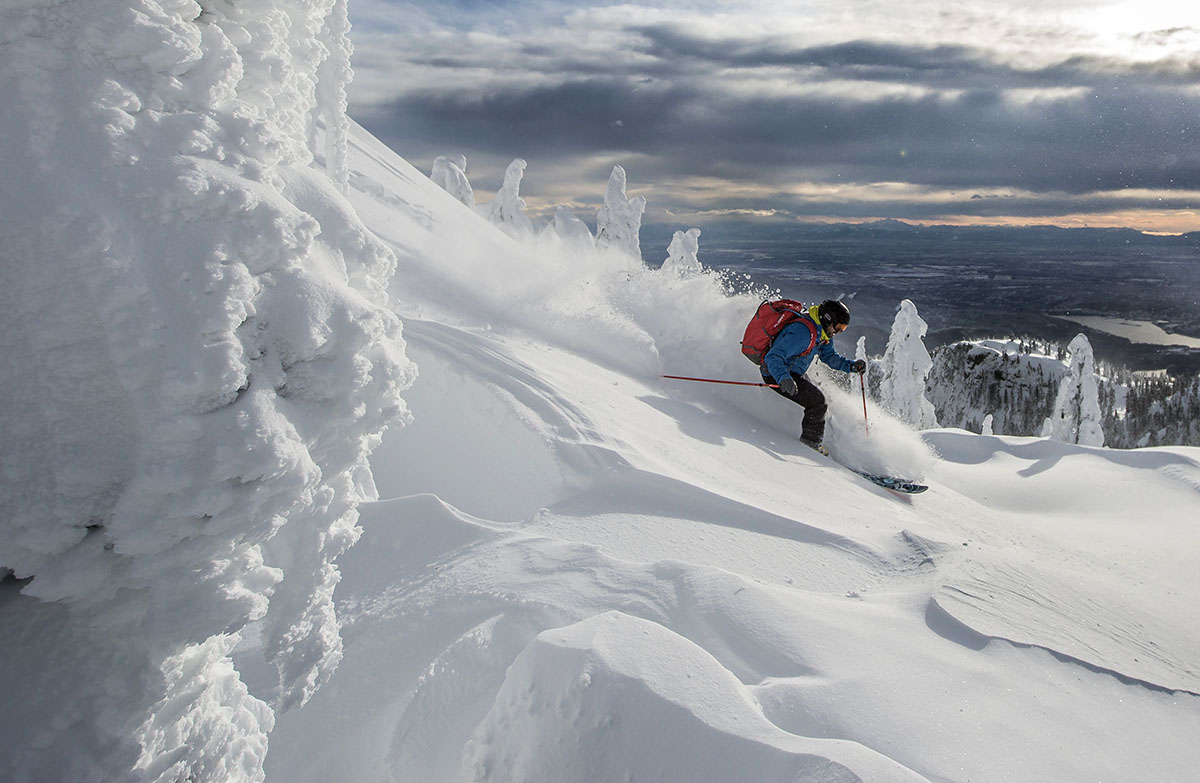
Quality water resistance in a ski pant is an absolute must. They come in contact with snow on nearly every run and really put the membrane and outer fabric to the test. For ultimate waterproof protection, look for a burly hardshell pant made with Gore-Tex, eVent, or NeoShell. Mid-range and entry-level options utilize the manufacturer’s in-house laminates that are still fully waterproof but most likely won’t have as long a lifespan. Seam taping and a DWR coating also are important for hard chargers to keep moisture from sneaking through. In terms of waterproofing, spending a little more does get you a nice upgrade in quality and longevity.
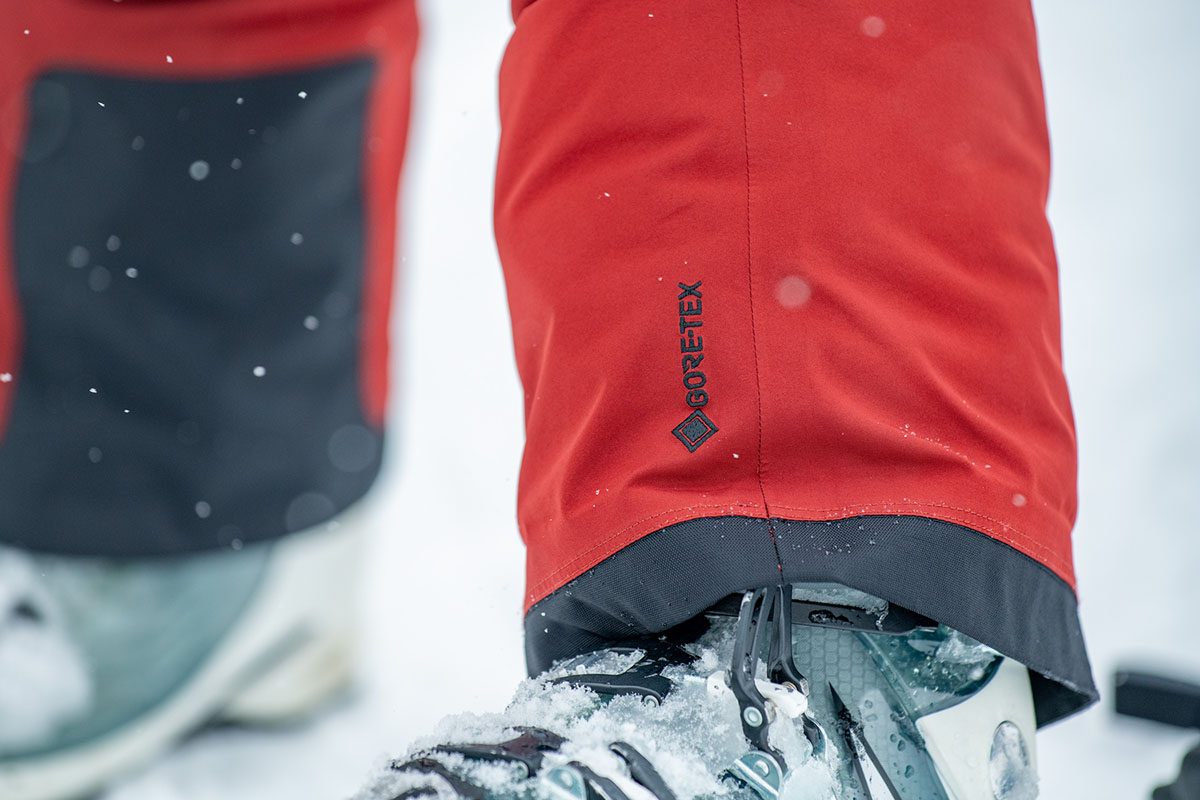
Backcountry skiers have a different set of priorities, so they do not always require full waterproofing. Less time sitting on a chair and more time on the skin track means that some backcountry skiers only need waterproofing in specific areas or a very water-resistant construction (especially for riders in regions known for dry snow like the Rocky Mountains). Your needs will vary but don't automatically discount a partially waterproof or non-waterproof pant—including the Outdoor Research Trailbreaker Tour from our list above—for backcountry use.
.jpg)
As we touched on above, breathability needs are closely aligned with your intended use(s). Resort riders, and especially those who plan to stay on groomed runs, don’t require a light and airy design. Most standard 2-layer constructions will offer sufficient breathability, and you can always select one with zippered vents to dump a little excess heat as needed. If you venture into the sidecountry, however, plan to mix in some touring days, or are a backcountry enthusiast, breathability then becomes an important consideration. Among waterproof builds, lightweight 3-layer constructions are the best ventilators (including the Patagonia Stormstride and Black Diamond Recon Stretch), and many softshell-inspired designs are even more impressive. You make compromises in all-out protection in harsh wind and wet snow, but air-permeable options like the Recon Stretch and Strafe Capitol 3L Shell are great performers when working hard.
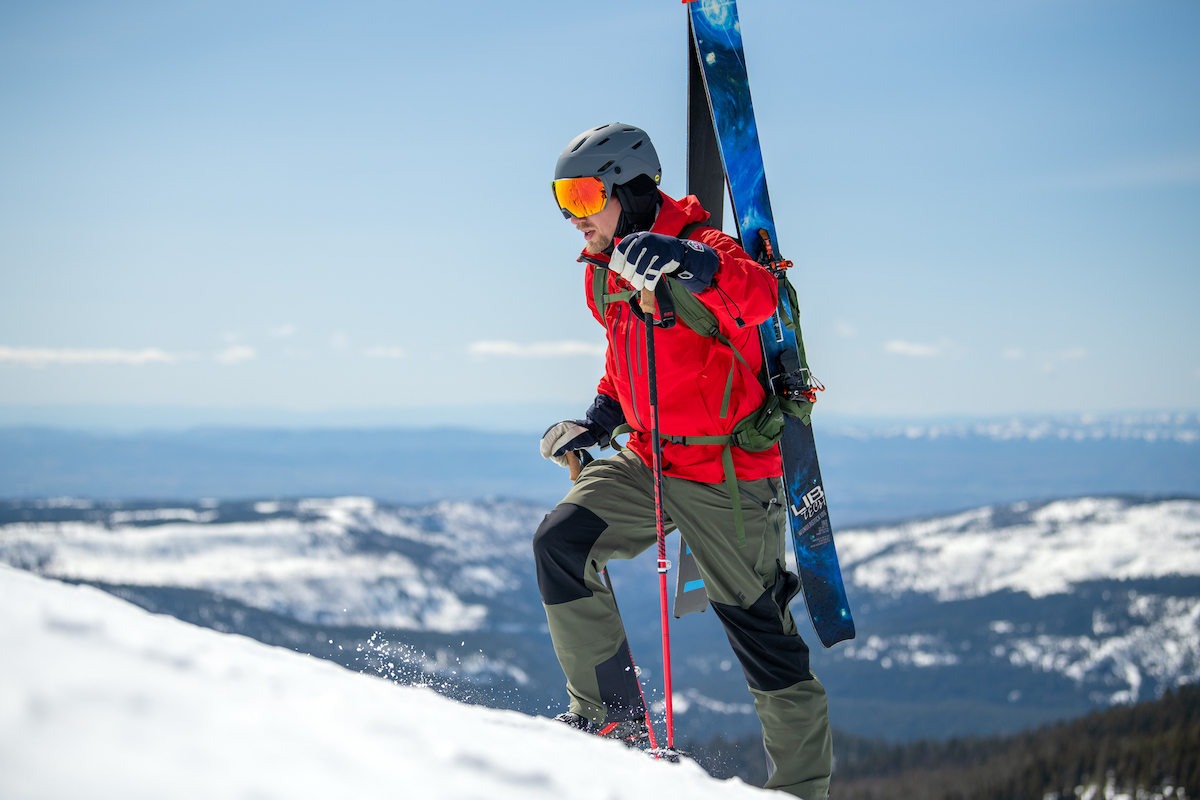
Ski pants see a lot of rough use—everything from boot buckles to metal edges and chair lifts can wreak havoc on the materials. As a result, they are a tough bunch overall. The most common way of determining ski pant durability is the fabric denier (D), which measures the thickness of the threads used for the shell material. Most resort-oriented designs are pretty substantial, including the Patagonia Storm Shift (150D) and The North Face Freedom (140D x 160D). On the other end of the spectrum, touring-focused pants like the Patagonia Stormstride (40D) make the most compromises in durability to maximize comfort, mobility, and performance on the go. Our top-rated pant, the Arc’teryx Sabre, does an excellent job of balancing needs for both activities with its high-quality 80D shell. It’s worth noting that many pants include a reinforced patch along the inside of the cuff (sometimes referred to as a scuff guard) for additional protection from ski edges.
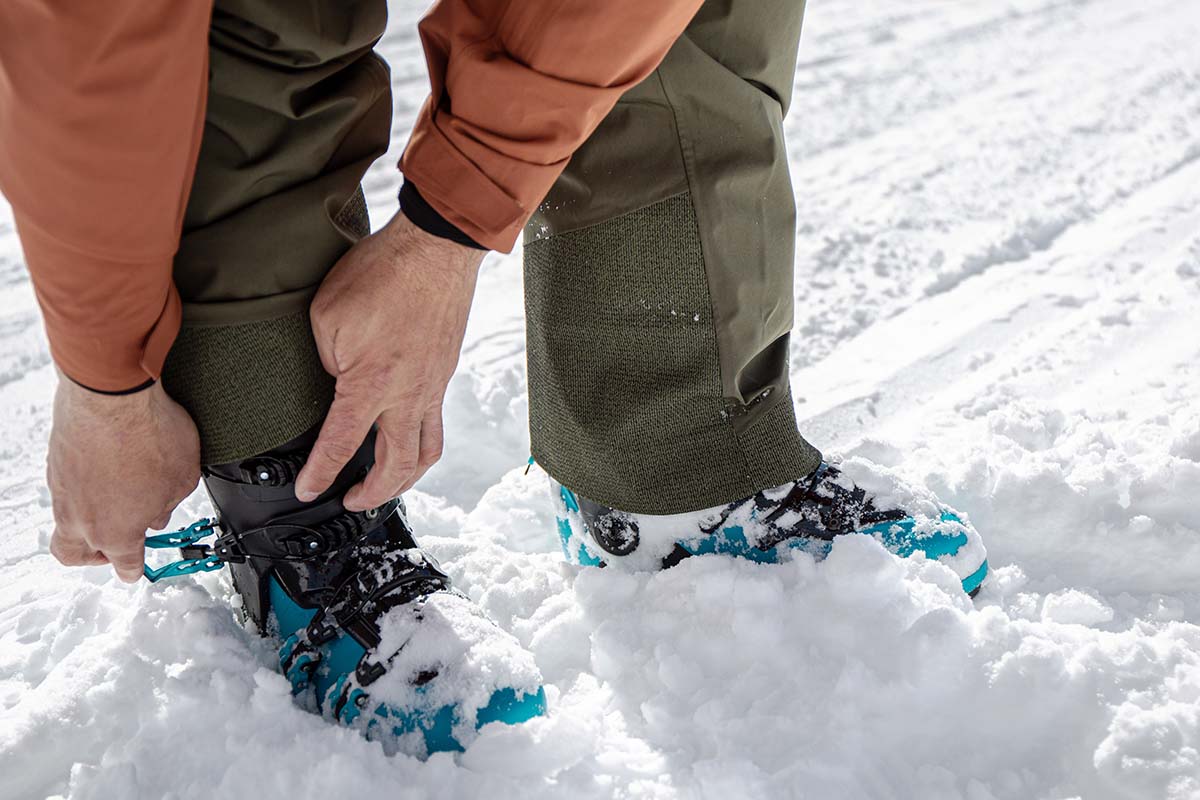
Another “either/or” decision when choosing ski pants is whether to opt for regular ski pants or a bib. Pants are the traditional choice and what most folks are familiar and comfortable with. They’re completely capable of resort or backcountry skiing and are much easier to slip on and off. The primary downside is felt when cold air or moisture finds its way up your back on the chairlift or after taking a fall.
Bibs are the remedy for these maladies as they offer better protection from the snow, wind, and wet. They also run a little warmer thanks to the extra layering that covers part of your upper body. While you don’t have to worry about any discomfort from a waistband, the straps that run over your shoulders can take some getting used to (and you’ll need to dial in the fit to keep them from moving around excessively or interfering with your backpack's shoulder straps). But deep powder explorers or those who are prone to good falls may prefer bib-style pants. The Flylow Gear Baker, Trew Gear Chariot Primo, Outdoor Research Hemispheres II, and Patagonia SnowDrifter are a few of our favorite bib designs.
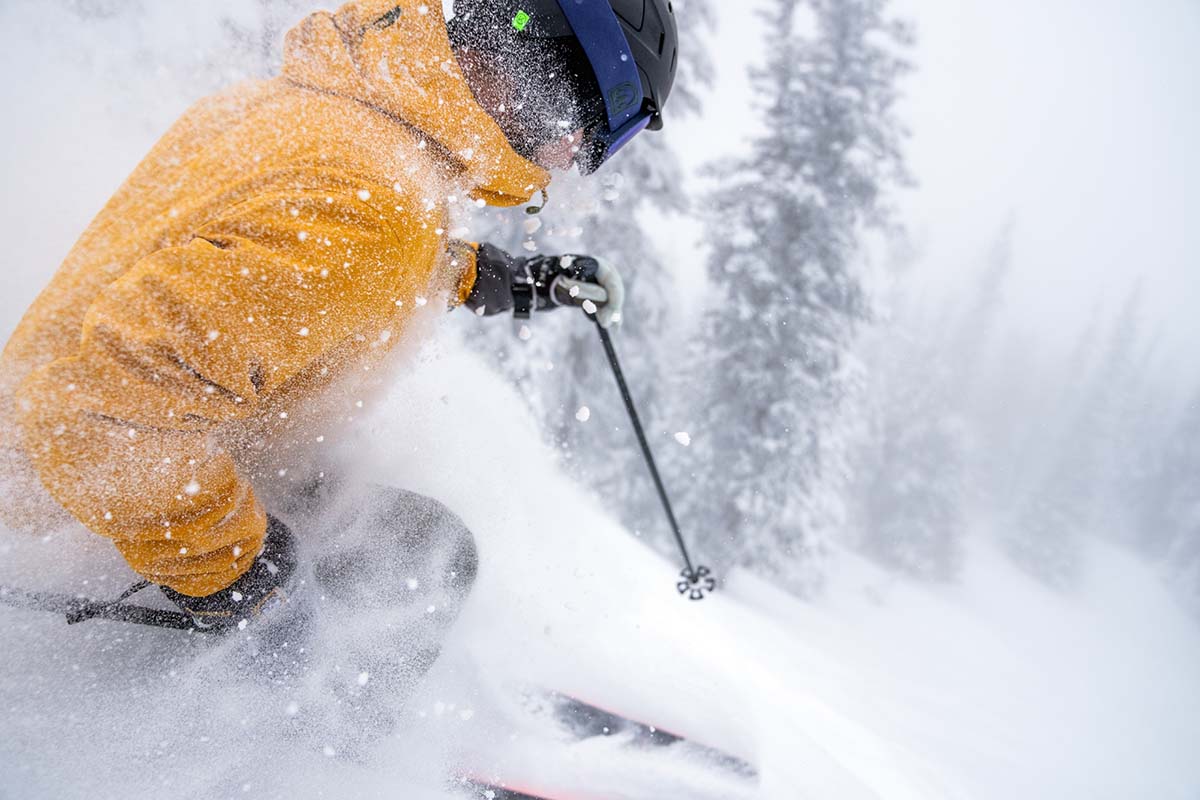
Pockets
Typically, your jacket or backpack will be your primary place to store personal items, but it’s still worth checking the pocket situation on a pair of ski pants you’re eyeing. We recommend looking for a couple of zippered pockets that can fit snacks or personal effects. Unless you really need the extra capacity, we’re not huge fans of cargo pockets for resort skiing—filling them with larger items feels ungainly on the mountain. Backcountry-specific pants like the Patagonia Stormstride and Outdoor Research Trailbreaker Tour put a greater emphasis on storage with dedicated pockets for items like a beacon.
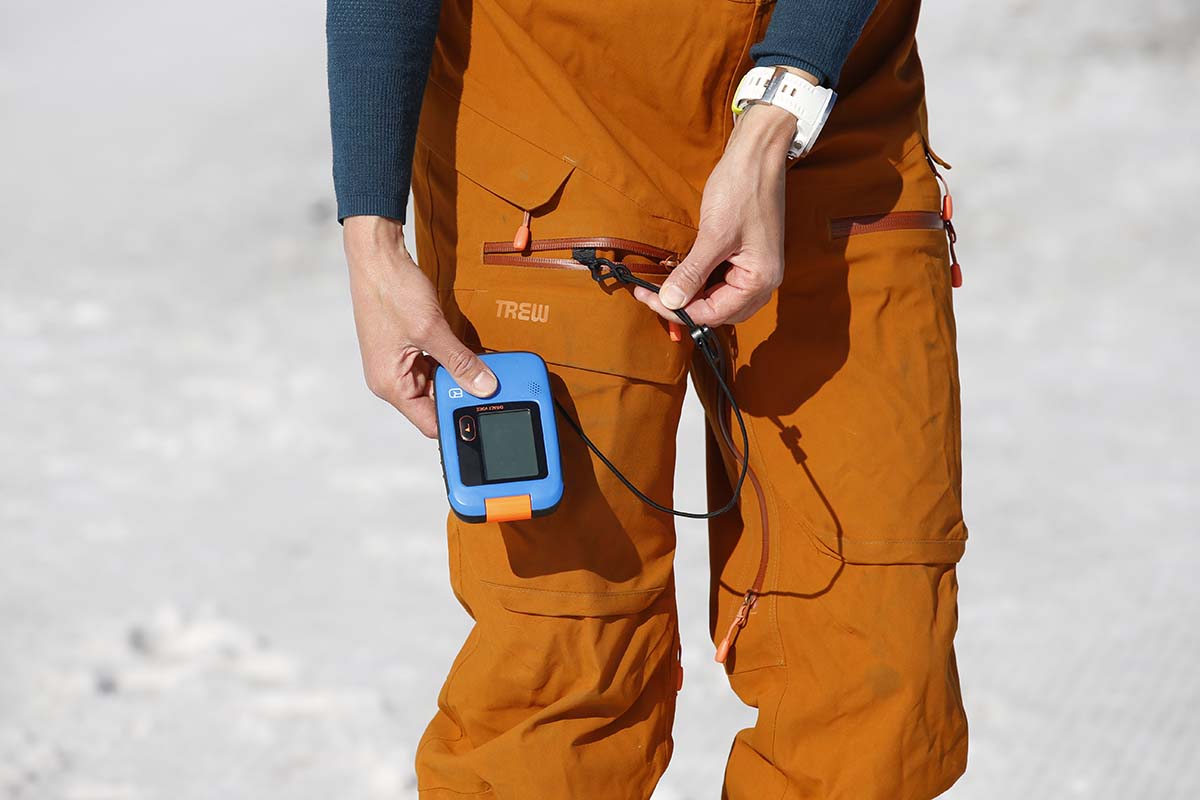
Ventilation
To aid in breathability, most ski pants offer a zippered ventilation system that amounts to pit zips for your legs. The most common locations for the zippered panels are along the inside of your upper legs or on the outside of your thighs. Either style will help dump a lot of heat, although the former design adds unwanted bulk and can occasionally impact comfort. Backcountry-specific pants often place the zippers on the outside of the legs in part for this reason. The Flylow Chemical Pant and the Trew Gear Eagle have vents on both sides of the leg, which provides excellent cross ventilation.
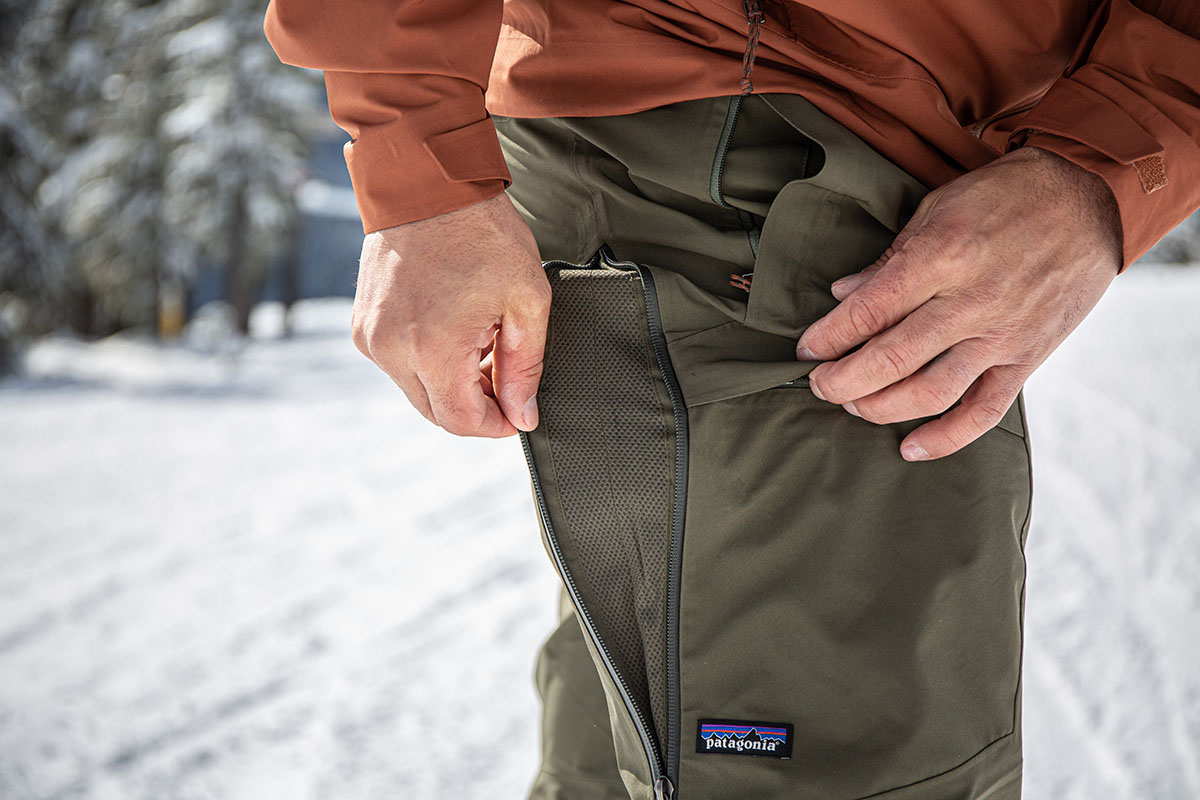
Recco
You may run into Recco listed as a feature on some mid-range and high-end ski pants. These are for skiers who make their way out of bounds or into areas where they may experience avalanche dangers. The Recco reflector built into your ski jacket or pant is a passive unit that doesn’t require batteries and can be picked up by the Recco detectors often carried by resort search and rescue. They lack the technology and strong signal of a dedicated search and rescue beacon, but they do provide an additional safety measure should you venture off-trail. We've found the Recco System website helpful if you want more information about the technology.
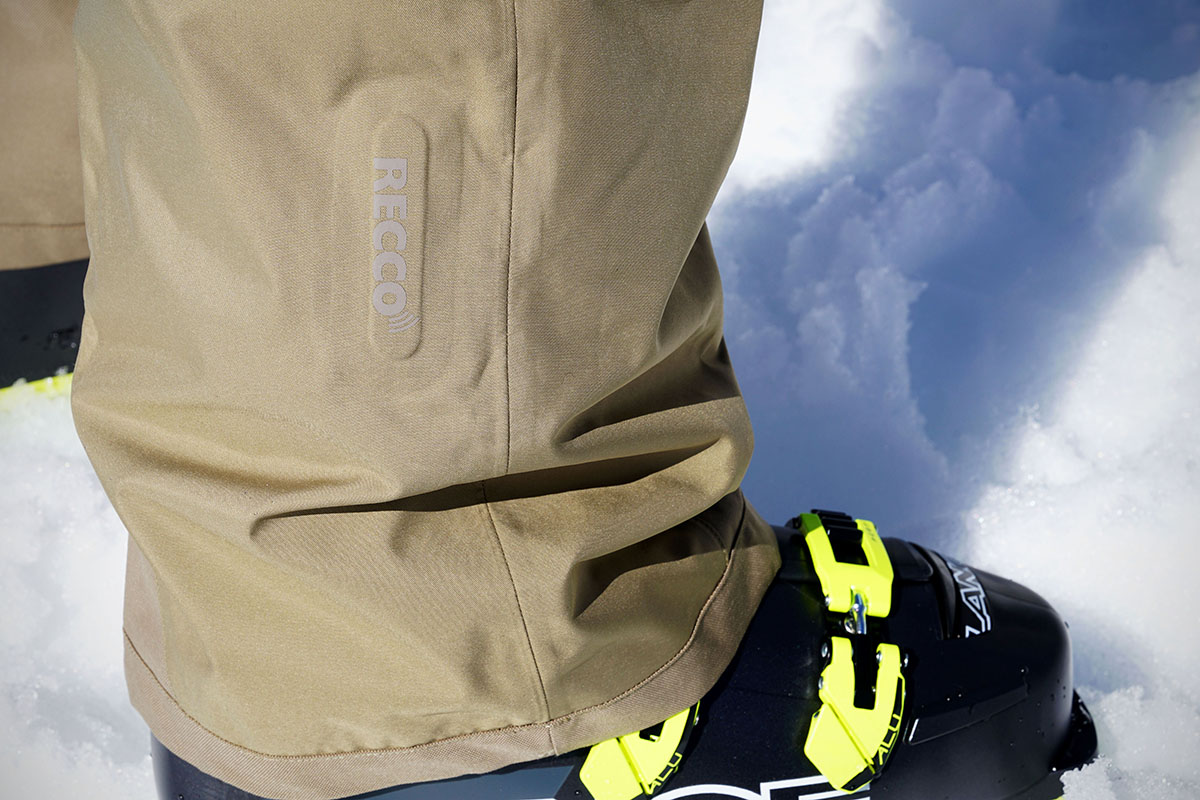
The best fit, no matter the type of skier or boarder you are, will come down to personal preference. There are, however, some helpful generalizations to be made. Most beginner and intermediate downhill skiers opt for a comfortable fit that is neither too tight nor too baggy. Backcountry touring types lean towards a slimmer cut for easier uphill hiking, and those who spend time in the park are inclined to choose a loose, relaxed fit. In the end, the most important thing is to find a fit that’s comfortable for you. Our preference is a bit of a more tailored cut as long as it doesn't negatively mobility. And it needs to have enough room to comfortably throw on a light or midweight baselayer underneath.
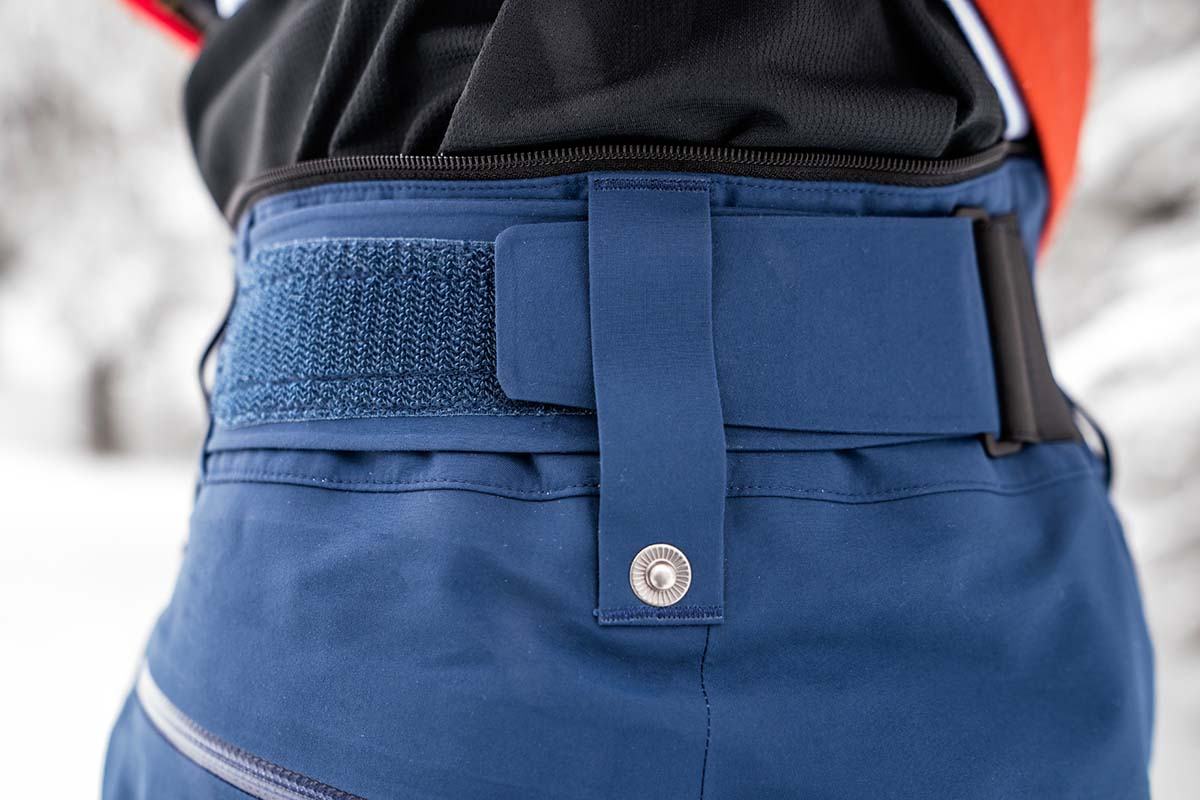
In recent years, there’s been a noticeable shift in sustainable practices within the ski apparel market. Led by brands like Patagonia and REI Co-op, we’re seeing greater use of recycled materials, particularly in the shell and lining fabrics. Further, a growing number of products, including Patagonia’s latest Storm Shift and Powder Town collections, are using DWR coatings that are PFC-free (short for perfluorocarbons, which is a non-biodegradable chemical). Many brands also utilize the bluesign system for sourcing materials responsibly and have Fair Trade Certified-sewn gear, which helps ensure the fair and ethical treatment of workers. One final way to purchase sustainably is to select quality products and repair old gear rather than buy cheap items that don’t last. Patagonia is a leader here as well, with an excellent repair program that’s managed both online and in their brick-and-mortar stores.
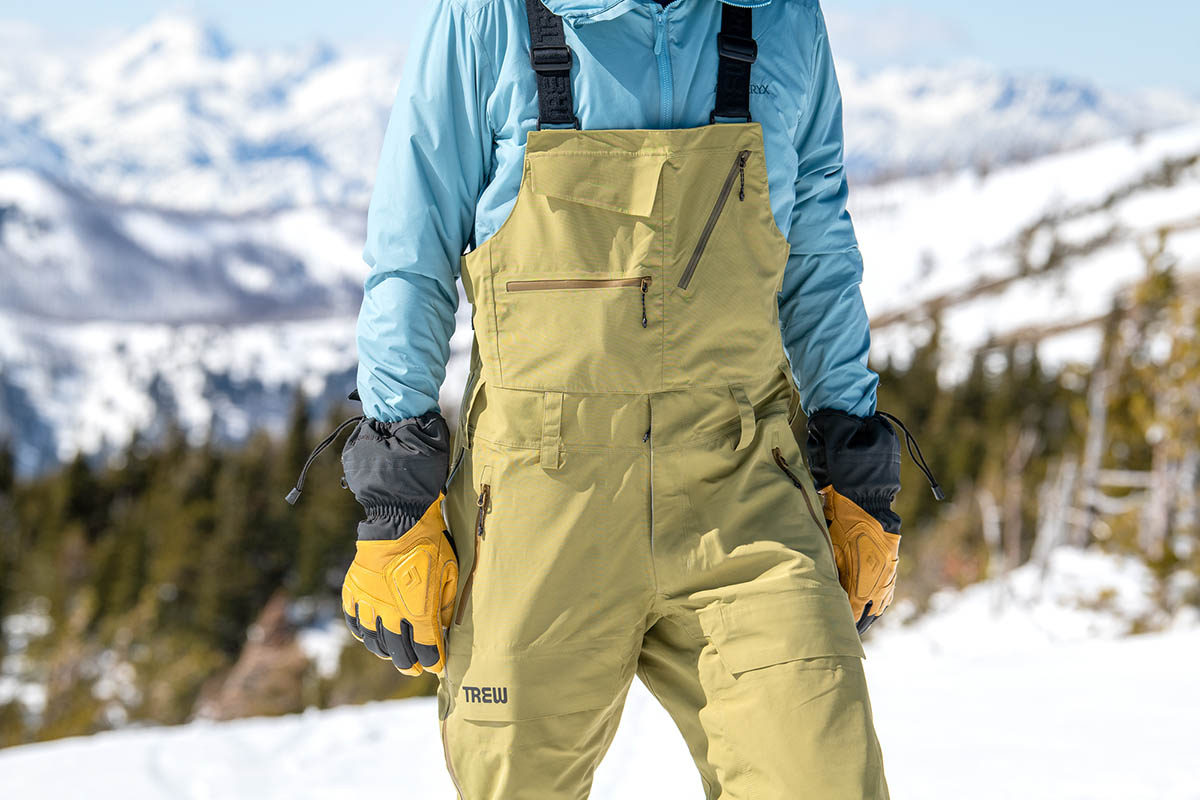
The layers you wear under your ski pants don’t get as much attention as those warming your core, but they remain an important consideration nevertheless. To start, it’s almost always a good idea to throw on at least a thin pair of long underwear both for resort and backcountry skiing. The extra layer not only provides insulation and protection from cold snow and freezing chairlift seats, but it also wicks moisture away from your skin. Further, the interiors of ski pants are often not very plush, with exposed mesh, zippers, and minimalist liners that become less comfortable as the day wears on.
.jpg)
In choosing a baselayer, it’s worth getting a soft and close-fitting design to maximize warmth. The best models are made with either synthetic or wool—cotton doesn’t insulate when wet, so it’s a bad idea even on a resort day. Synthetics are the cheaper option and efficiently wick moisture, but merino wool is our favorite. It’s very warm for its weight and naturally resists odor better than a polyester alternative. Baselayers are offered in a range of thicknesses, including lightweight designs for warm days or backcountry use, and mid and heavyweight options for cold days at the resort. And in particularly frigid conditions, you can always double up your baselayers to increase warmth.
Back to Our Top Ski Pant Picks Back to Our Ski Pant Comparison Table